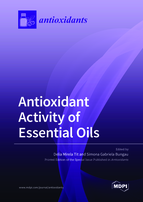Antioxidant Activity of Essential Oils
A special issue of Antioxidants (ISSN 2076-3921). This special issue belongs to the section "Natural and Synthetic Antioxidants".
Deadline for manuscript submissions: closed (30 November 2022) | Viewed by 63382
Special Issue Editors
2. Doctoral School of Biomedical Sciences, University of Oradea, 410087 Oradea, Romania
Interests: pharmacology; alternative therapies; biochemistry; public health; therapeutics; One Health; sustainability in health; ecology
Special Issues, Collections and Topics in MDPI journals
Interests: pharmacy; pharmacology; public health; medicine; chemistry; clinical trials; nutrition; polyphenols; oxidative stress; antioxidants
Special Issues, Collections and Topics in MDPI journals
Special Issue Information
Dear Colleagues,
In the last few years, the high efficacy of herbal antioxidant products in various diseases has been reported. Numerous essential oils (EOs) with antioxidant properties must be mentioned here, their use as natural antioxidants being a field of real interest—especially in food science and medicine.
EOs are complex products, usually consisting of over 50 components in varying concentrations. Those EO substances described as having antioxidant activity represent an important fraction of the total compounds, being often indicated as a potential source in the discovery and development of new bioactive compounds, with medical, pharmaceutical, cosmetic, etc. use. Additionally, EOs and their constituents have been studied as alternative additives in the food industry, emphasizing their advantages over synthetic antioxidants that often have negative effects on health.
This Special Issue aims to collect original research articles and reviews dealing with all aspects of the antioxidant activity of essential oils:
- the chemistry and mechanisms at the basis of EOs’ antioxidant activity;
- methods used to measure antioxidant activity;
- in vitro and in vivo antioxidant activity;
- the pharmaceutical, cosmetic, and food applications of bioactive compounds from EOs and their mechanisms, focusing on their antioxidant activity;
- testing of combinations of oils, respectively combinations with other antioxidant compounds in order to increase the antioxidant potential;
- the antioxidant activity of innovative formulations, such as active packaging and nano/microparticles containing EOs.
Papers describing recent results in the qualitative-quantitative analysis of EOs and their antioxidant activity will be particularly welcome.
Prof. Dr. Delia Mirela Tit
Prof. Dr. Simona Bungau
Guest Editors
Manuscript Submission Information
Manuscripts should be submitted online at www.mdpi.com by registering and logging in to this website. Once you are registered, click here to go to the submission form. Manuscripts can be submitted until the deadline. All submissions that pass pre-check are peer-reviewed. Accepted papers will be published continuously in the journal (as soon as accepted) and will be listed together on the special issue website. Research articles, review articles as well as short communications are invited. For planned papers, a title and short abstract (about 100 words) can be sent to the Editorial Office for announcement on this website.
Submitted manuscripts should not have been published previously, nor be under consideration for publication elsewhere (except conference proceedings papers). All manuscripts are thoroughly refereed through a single-blind peer-review process. A guide for authors and other relevant information for submission of manuscripts is available on the Instructions for Authors page. Antioxidants is an international peer-reviewed open access monthly journal published by MDPI.
Please visit the Instructions for Authors page before submitting a manuscript. The Article Processing Charge (APC) for publication in this open access journal is 2900 CHF (Swiss Francs). Submitted papers should be well formatted and use good English. Authors may use MDPI's English editing service prior to publication or during author revisions.
Keywords
- essential oils
- antioxidant activity
- innovative formulations
- chemistry and mechanisms of antioxidant activity








